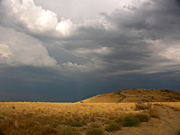- Number 319 |
- August 30, 2010
Clouds + mineral dust = rain

Scientists recently provided
insights into the relationship
between higher levels of
mineral dust and precipitation,
helping to reduce the
uncertainty in atmospheric
models. (Photo courtesy of
Andrew Rakowski.)
Large dust particles increase the likelihood of rain, according to a 14-year examination of 9 field studies around the world. Scientists from DOE’s Pacific Northwest National Laboratory, Colorado State University, North Carolina State University, Oregon State University, University of Colorado, and National Center for Atmospheric Research found the number of dust particles larger than 0.5 micrometers in diameter closely correlates with the number of ice nuclei. The nuclei are known to form seeds for rain droplets in clouds.
This study’s results give scientists a more accurate picture of how ice nuclei form. Using this information, scientists can reduce the uncertainty in atmospheric models by a factor of 100. Past predictions assumed 10 times more ice nuclei were present in clouds. This work was funded by DOE's Office of Biological & Environmental Research, Atmospheric System Research Grant, NASA's Modeling and Analysis Program, and National Science Foundation.
[Kristin Manke, 509.372.6011,
Kristin.manke@pnl.gov]
